-
项目名称
- 国家自然科学基金"紫色土坡耕地地表与近地表水流交互作用侵蚀机理研究"(41571265)
-
第一作者简介
- 黄永超(1992-), 男, 硕士研究生。主要研究方向:土壤侵蚀。E-mail:1909879410@qq.com
-
通信作者简介
- 陈晓燕(1971-), 女, 研究员。主要研究方向:土壤侵蚀与流域治理。E-mail: c400716@126.com
-
文章历史
-
收稿日期:2018-03-07
修回日期:2018-06-21
土壤侵蚀易引发全球范围内土地退化、土壤肥力流失、河流淤积等一系列生态问题[1]。三峡库区(重庆段)现有耕地面积389.10万hm2,其中69%以上为紫色土坡耕地[2]。该区紫色土坡耕地作为土壤侵蚀的主要来源地,其年土壤侵蚀量高达9 854 t[3]。土壤水分入渗过程是流域水循环的重要组成部分,与土壤水分再分配、土壤侵蚀、养分随水分的迁移、农业面源污染等问题密切相关[4]。
野外土壤中普遍存在大孔隙,其对土壤水分运动有着极其重要的影响。P. F. Germann[5]针对土壤水在大孔隙中快速迁移的现象,提出优先流的概念,并指出优先流就是水流通过大孔隙而绕过土壤基质快速向下迁移的物理过程;刘亚平等[6]对土壤非饱和带中的优先流进行了研究,认为优先流主要分为:大孔隙流、指流和漏斗流;庄季屏[7]也对优先流的特点及研究方法进行了简要的阐述;S. E. Allaire等[8-9]指出,如果土壤孔隙与地表不连接或者被遮盖,优先流则不发生,上部土层与基质入渗区域有相同的入渗特征。由于各方面条件的限制,对优先流的定量化研究只是近10多年的事,如F.Staghitti等[10]、P. L. Anari等[11]、M. L. Villamizar等[12]、和D. Mcbride[13]等,他们都尝试建立穿过裂隙和大孔隙优先流的具体模型,然而这些模型的模拟效果均难以令人满意。目前对优先流的量化研究主要集中在采用射线扫描法[14]和染色示踪法[15],前者通过分析大孔隙结构,后者通过分析染色面积,定量优先流占整个入渗的比例。
在S. E. Allaire等[8-9]的研究基础之上,张婧[16]对黄土林地土壤入渗与优先流测量的方法进行了研究,提出表置环式入渗仪测量土壤基质与优先流入渗的方法。这种试验装备不仅能对土壤基质入渗和优先流进行定量测量,而且克服了传统环式入渗仪安装过程中存在的误差问题。前人有关紫色土土壤入渗研究多集中在土壤总入渗研究,土壤基质入渗与优先流研究较少,如王红兰等[17]通过室内土柱试验,采用解析法定量化评价紫色土坡耕地优先流的贡献率。针对紫色土土壤基质与优先流的定量化测定的研究尚未报道。鉴于此,笔者选取坡耕地耕层紫色土为研究对象,定量化探讨紫色土耕层土壤基质与优先流入渗特征,以期为紫色土耕层土壤入渗过程机理研究提供科学依据。
1 研究区概况研究区位于重庆市北碚区歇马镇大磨滩村(E 106°22'30.00", N 29°45'29.53"),地貌形态以浅丘为主,海拔244~257 m,属亚热带季风气候湿润区,多年平均气温约为18.2 ℃,多年平均降雨量约为1 089.8 mm。试验地为大磨滩村的1块玉米地,试验地土壤基本理化性质如表 1所示。
| 表 1 玉米地不同深度土壤理化性质 Tab. 1 Soil physic-chemical properties at different depths of corn field |
研究区耕层紫色土、表置环式入渗仪(外环直径为40 cm、内环直径20 cm、高10 cm)、环刀(5 cm×5 cm)、水桶、水壶(1 L)、铁锹、尺子、卷尺、亚甲基蓝、细砂和细土(过0.25 mm筛)(图 1)、细纱布、5 cm×5 cm纸片、毛刷、秒表、数码相机。
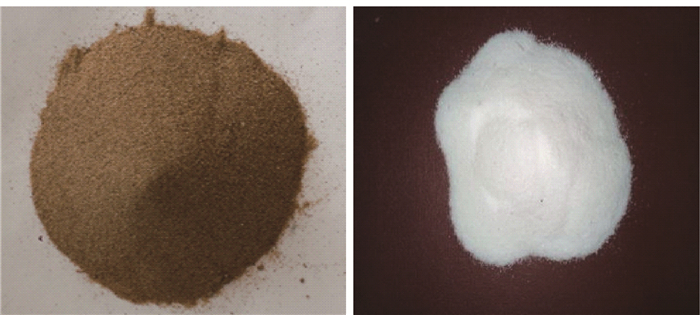
|
图 1 遮挡内外环中大孔隙的试验用土(左)和用砂(右) Fig. 1 Experimental soil (Left) and sand (Right) to cover the large pores in the outer and inner rings |
本试验开展时间为2017年6月中旬,在研究区选取面积为100 m2的玉米地1块,于相邻的玉米种植间隔,依次选取地势相对平坦的3个试验点(A、B、C)。选定试验点后,小心地清除地表杂物,使土壤表面完全裸露。每个试验点间隔2 m分别放置2个表置环式入渗仪作为1组试验,分别测定该点土壤基质和总入渗率。测量方法示意图及入渗仪实物图见图 2。
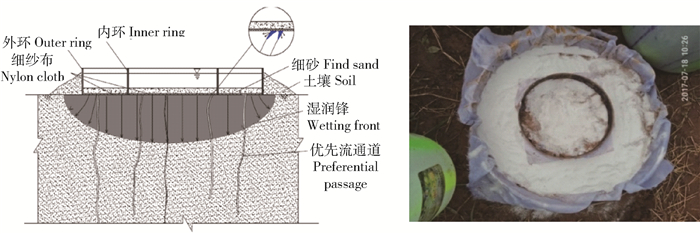
|
图 2 测量方法示意图(左)及入渗仪实物图(右) Fig. 2 Sketch map of measurement method (Left) and physical picture of infiltration meter (Right) |
在表置环式入渗仪内、外环内侧分别贴上刻度标签,然后将双环同心轻轻压入土壤1 cm,在内外环与地面接壤的地方进行培土,以消除铁环进入土体时产生的空隙,防止环内溶液侧漏。安装过程中尽量保持水平,减少对地表的扰动。细纱布铺在整个环内的土壤表面,将过0.25 mm筛的细土均匀地洒在内环和外环之间,其厚度约为1 cm,再铺2 cm的细砂于细土之上用于遮挡土壤表面的大孔隙,保证水分只通过土壤基质。为了减少加水时对砂子的冲刷,在砂子表面放1张5 cm×5 cm的纸板,水加在纸板上以缓冲水流。以4 g/L的质量浓度混合亚甲基蓝溶液,在内环加入混有亚甲基蓝的溶液,外环加入清水。内外环同时加入等高水位,第1次加水深度为4~5 cm,加水深度达到4 cm及以上时立即按下秒表,并记录水深刻度线,然后由秒表记录每下降0.5 cm水位消耗的时间,当水位不足时,向环内补充水和亚甲基蓝溶液至原水位刻度线,继续由秒表记录每下降0.5 cm水位消耗的时间,保持整个入渗过程中内外环水位相同。每次试验入渗时间控制在90 min左右。入渗率由下式计算:
| $ {\rm{IR}} = \Delta I/\Delta t。$ | (1) |
式中:IR为入渗率,mm/min;ΔI(mm)为内环在Δt时段(min)的入渗水分量。
2.2.2 优先流第1个表置环式入渗仪用于测量土壤基质入渗量Qm(t)(mm),第2个用于测量土壤总入渗量Qt(t)(mm)。总入渗过程即将表置环式入渗仪直接放置地表进行测量,地表不作任何处理。
1个试验地点的优先流入渗量Qp(t)(mm)可由下式表示:
| $ {Q_{\rm{p}}}\left( t \right) = {Q_t}\left( t \right) - {Q_{\rm{m}}}\left( t \right)。$ | (2) |
将式(2)对时间t求导,可得
| $ {\rm{I}}{{\rm{R}}_{\rm{p}}} = {\rm{I}}{{\rm{R}}_t} - {\rm{I}}{{\rm{R}}_{\rm{m}}}。$ | (3) |
式中:IRp为优先流入渗率,mm/min;IRt 为总入渗率,mm/min;IRm为土壤基质入渗率,mm/min。
1次入渗试验完成24 h后,开挖该入渗土体剖切面。首先沿外环的切线方向,然后是内环的切线方向,接着是沿内环的1/4和1/2处进行土体垂直剖切面开挖。垂直剖切面开挖完成后,在内环的1/2处所挖剖面上,分2层(0~20和20~40 cm)分别用环刀、铝盒和取样袋进行取样。每个土层取3个样品,带回实验室测量初始质量含水率、比重、有机质含量和土壤机械组成,并取3个样品的测量平均值。水平剖切面在土体5、10、20和30 cm深处开挖。每次试验包括水平和垂直剖切面共8个。每个剖切面显出之后,用毛刷刷走剖切面散土,用数码相机拍摄水平和垂直剖切面的湿润特征。
3 结果与分析 3.1 土壤基质入渗3个不同试验点的土壤基质入渗率和累积入渗量由图 3所示,土壤基质初渗速率介于8.38~32.66 mm/min之间,稳渗速率介于3.15~4.20 mm/min之间,平均土壤入渗率介于3.62~6.26 mm/min之间,累积入渗量介于362~626 mm之间。
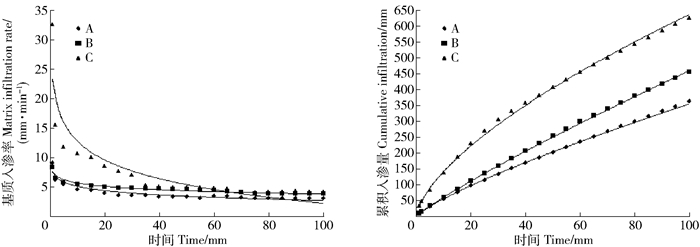
|
A、B、C分别为3个试验点中的一个,下同。 A, B, and C is one of the 3 test sites in the study, respectively. The same below. 图 3 玉米地不同试验点土壤基质入渗率和累积入渗量随时间变化情况 Fig. 3 Soil matrix infiltration rate and cumulative infiltration curve at different test sites in corn field |
水分进入含有大孔隙的土壤后入渗路径分为2个区域。第1个区域是土壤基质,主要受土壤基质势控制,符合达西定律,第2区域为优先流通道。由达西定律可知,土壤基质初始入渗率很高,当更多的水分进入土壤后,土壤基质势梯度降低,入渗率降低;随着时间延长,土壤达到饱和后,土壤基质势为零,此时的入渗率达到最低值即稳定入渗率。由图 3可以看出,测量得到的入渗率符合达西定律中关于土壤基质入渗率随时间的变化特征。本研究利用现在广泛使用的Philip入渗模型和Kostiakov入渗模型拟合不同试验点测量得到的入渗过程,如表 2所示,其相关系数均>0.93,表明测量的入渗过程能很好地表征土壤的基质入渗特征。
| 表 2 研究区耕层土基质入渗率的模型拟合结果 Tab. 2 Model fitting results of soil matrix infiltration rate in plough soil |
亚甲基蓝是可视化优先通道的一个重要工具。对于无大孔隙的土壤,亚甲基蓝只能停留在土壤表面或者进入基质0.5~1 mm的深处[18]。土壤剖切面处如无亚甲基蓝染色区域,即可说明无优先流发生。垂直和水平剖切面如图 4和图 5所示,垂直和水平剖切面处土壤均未着色,表明该入渗过程无优先流经过,所测量的入渗率是土壤基质入渗率。
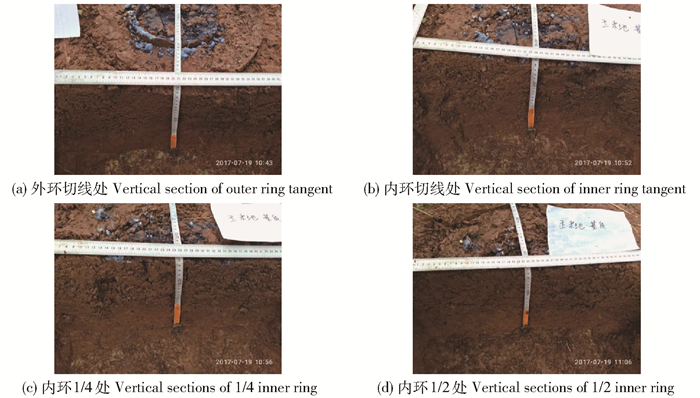
|
图 4 试验点B土壤基质入渗过程垂直剖面图 Fig. 4 Vertical section of soil matrix infiltration in test site B |
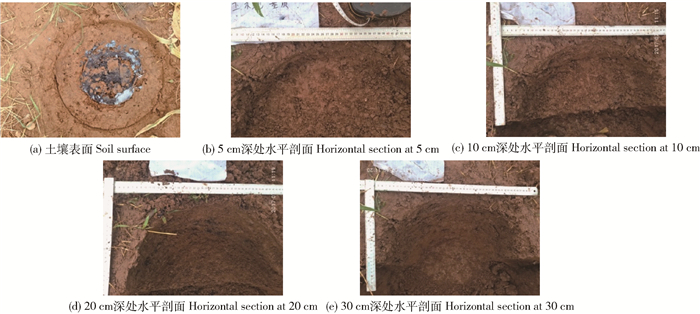
|
图 5 试验点B土壤基质入渗过程水平剖面图 Fig. 5 Horizontal section of soil matrix infiltration in test site B |
3个不同试验点的土壤总入渗率和累积入渗量如图 6所示,土壤总初渗速率介于45.39~75 mm/min之间,稳渗速率介于3.39~5.79 mm/min之间,平均土壤入渗率介于5.93~16.93 mm/min之间,累积入渗量介于593~1 593 mm之间。土壤水平和垂直剖切面如图 7和图 8所示,染色部分均出现在垂直和水平剖切面处,表明该入渗过程存在优先流经过,所测量的入渗率为土壤总入渗率。
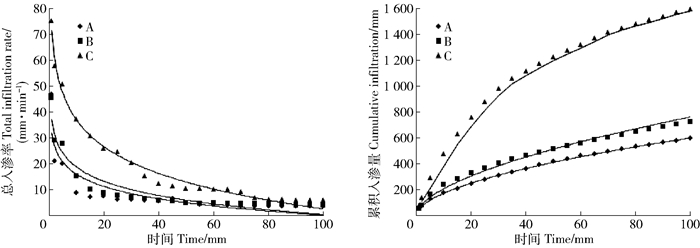
|
图 6 玉米地不同试验点土壤总入渗率和累积入渗量随时间变化情况 Fig. 6 Total infiltration rate and cumulative infiltration curve of soil at different test sites in corn field |
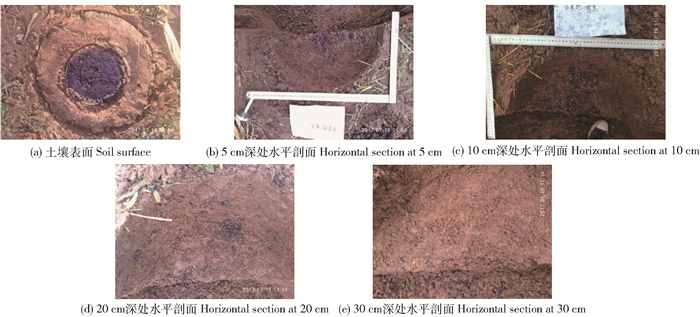
|
图 7 试验点C土壤优先流土壤水平剖面图 Fig. 7 Horizontal section of soil preferential flow in test site C |
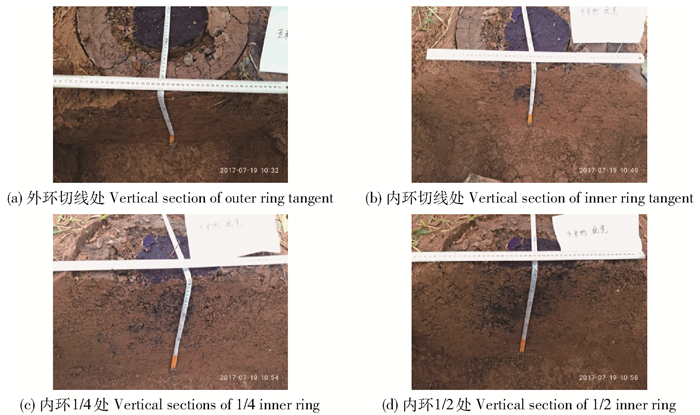
|
图 8 试验点C土壤优先流土壤垂直剖面图 Fig. 8 Vertical section of soil preferential flow in test site C |
玉米地土壤优先流入渗率和累积入渗量随时间的变化过程如图 9所示,优先流初渗速率介于37.01~42.34 mm/min之间,稳渗速率介于0.04~1.59 mm/min之间,平均土壤入渗率介于2.31~9.67 mm/min之间,累积入渗量介于231~967 mm之间。

|
图 9 玉米地不同试验地点土壤优先流入渗率及其累积入渗量曲线 Fig. 9 Soil preferential inflow rate and cumulative infiltration curve at different test sites in corn field |
水分进入含有大孔隙的土壤后的第2区域入渗路径即为优先流通道,水流通过土壤大孔隙或微空隙进入土体,运动过程主要受重力势控制,不符合达西定律和Richard's方程及已有的入渗模型[19-20]。这一过程是多维向的,它的形式主要依靠孔隙的几何尺寸[21]。R. J. Luxmoore [22]强调除了孔隙尺寸外,孔隙的弯曲度和连通性也控制大孔隙优先流的运移。由表 3可以看出:初始阶段(0~10 min)优先流入渗率很高,高达33.20 mm/min,土壤基质入渗率也可达13.73 mm/min,此阶段基质入渗率是优先流入渗率0.3~0.5倍;当更多的水分进入土壤孔隙后,优先流入渗率显著降低,10~60 min时段基质入渗率是优先流入渗率的0.6~2.8倍,稳渗阶段(60~90 min)基质入渗率是优先流入渗率的1.5~16.5倍。
| 表 3 不同入渗阶段土壤基质和优先流入渗率 Tab. 3 Soil matrix infiltration rate and preferential flow infiltration rate at different infiltration stages |
莫斌等[23]采用点源入渗法研究了紫色土不同土地利用方式下土壤入渗特征,初始质量含水比例为22.83%,密度为1.39 g/cm3,孔隙度为48.42%。结果表明,坡耕地的初始入渗率为8.46 mm/min,稳定入渗率为0.33 mm/h。李雪垠等[24]采用一维垂直水头法,研究了紫色土中砾石夹层对土壤水分入渗的影响。结果表明:当碎石含量为0时,土壤比重为1.39 g/cm3,孔隙度为49.06%,土壤初始入渗率为49.02 mm/min,稳定入渗率为1.19 mm/min。马晓刚等[25]采用室内环刀法研究了丘陵区不同土地利用类型紫色土入渗特征,土壤质地为黏粒(<0.001 mm)12.44%,粉粒(0.050~0.001 mm)55.14%,砂粒(1.0~0.05 mm)32.40%,密度为1.43 g/cm3,有机质质量分数1.45 g/kg,孔隙度为45.80%,测得传统坡耕地紫色土初始入渗率为28.20 mm/h,稳定入渗率为5.91 mm/h。本研究区玉米地土壤总的初渗速率介于45.39~75 mm/min之间,稳渗速率介于3.39~5.79 mm/min之间,所测得的土壤总初渗速率和稳渗速率远高于莫斌等[23]和马晓刚等[25]所得到的紫色土入渗率,略高于李雪垠等[24]在该条件下所测得的土壤入渗率。究其原因,本研究测得的玉米地耕层土壤密度值和孔隙度值均较莫斌等[23]、李雪垠等[24]和马晓刚等[25]研究中有所不同,土壤理化性质的差异则是造成本研究土壤入渗率不同于上述3人研究成果的直接原因;此外,本研究区玉米地土壤深度约为40 cm,耕层土壤底部为不透水基岩,壤中流的产生也可能对其入渗性能存在一定的影响。
K. Beven[26]和P. F. Germann[5]指出,优先流通道或者大孔隙可能只占土壤体积的很少部分,但其过水能力超过土壤基质本身几个数量级。本试验结果与此有所不同。此外,张婧[16]对黄土林地土壤基质入渗与优先流的测量结果表明:在初始阶段(0~10 min)优先流入渗率是土壤基质入渗率的10.2倍,稳渗(60~90 min)时段优先流入渗率是基质入渗率的2.3倍,优先流相对土壤基质入渗占据绝对优势。而本次试验结果表明,紫色土耕层土壤优先流在初始入渗阶段,入渗率是基质入渗率的2.4倍左右,达到稳定时的优先流入渗率比稳定基质入渗率要小,这与张婧的结果有显著差异。原因可能是本研究供试土壤的质地和结构较K. Beven[26]、P. F. Germann[5]和张婧[16]的研究结果有所不同。
目前,土壤入渗率测量方法主要有双环法[27]、圆盘入渗仪法[28]、点源入渗法[29]、人工模拟降雨法[30]等。莫斌等[31]应用不同的土壤入渗测量方法对紫色土土壤入渗特征进行了研究,结果表明点源入渗法测定入渗过程规律其效果最好,其次为双环法。其中点源入渗法具有省时、省水和准确等优点,点源入渗法在紫色土坡耕地测定土壤入渗性能中有较好的应用性,但也有一定的局限性,不能对优先流进行定量的测定。双环法[27]由于操作过程简单、计算方法直观和设备价格低等特点,是目前应用非常广泛也是最经典的土壤入渗性能测量方法。但雷廷武等[32]指出,双环法在打击双环入渗仪入土过程中产生的震动造成环壁和土壤分离形成缝隙,为优先流的形成提供了便利通道,从而影响测量结果。然而本试验不仅能避免或减小入渗仪入土过程中对土壤的扰动,提高试验精度,还能对优先流进行定量的测定,故本研究能真实地反映野外耕层紫色土的入渗过程,对紫色土耕层土壤入渗过程机理的进一步研究具有重要的参考价值。
5 结论本研究紫色土耕层土壤优先流的累积入渗量是土壤基质入渗量的0.6~1.5倍。初始入渗阶段,基质入渗率与优先流入渗率的比值为0.3~0.5,入渗过程中,基质入渗率与优先流入渗率比值逐渐增大,达到稳渗阶段后,优先流入渗率明显减小,基质入渗与优先流入渗率比值为1.5~16.5。土壤基质和优先流入渗在紫色土坡耕地土壤水文过程中具有同等重要的作用。耕层紫色土均可用Philip入渗模型和Kostiakov入渗模型模拟,且拟合效果较好。本研究结果能够较为真实地反映野外耕层紫色土的入渗特征。
| [1] |
陈思旭, 杨小唤, 肖林林, 等. 基于RUSLE模型的南方丘陵山区土壤侵蚀研究[J].
资源科学, 2014, 36(6): 1288.
CHEN Sixu, YANG Xiaohuan, XIAO Linlin, et al. Study of soil erosion in the southern hillside area of China based on RUSLE model[J]. Resources Science, 2014, 36(6): 1288. |
| [2] |
郭进, 文安邦, 严冬春, 等. 三峡库区紫色土坡地土壤颗粒流失特征[J].
水土保持学报, 2012, 26(3): 18.
GUO Jin, WEN Anbang, YAN Dongchun, et al. Particle characteristics of eroded purple soil from slope land in the Three Gorges Reservoir region[J]. Journal of Soil and Water Conservation, 2012, 26(3): 18. |
| [3] |
王玉宽, 文安邦, 张信宝. 长江上游重点水土流失区坡耕地土壤侵蚀的137Cs法研究[J].
水土保持学报, 2003, 17(2): 77.
WANG Yukuan, WEN Anbang, ZHANG Xinbao. Study of soil erosion on cultivated slope land in severe soil loess regions of upper reaches of Yangtze River Basin using137Cs technique[J]. Journal of Soil and Water Conservation, 2003, 17(2): 77. DOI: 10.3321/j.issn:1009-2242.2003.02.022. |
| [4] |
龙天渝, 王延青, 安强, 等. 积水条件下连续和间歇供水对上壤入渗特性的影响[J].
水土保持通报, 2012, 32(3): 7.
LONG Tianyu, WANG Yanqing, AN Qiang, et al. Effects of continuous and intermittent water supply on infiltration characteristics of a purple soil under ponding condition[J]. Bulletin of Soil and Water Conservation, 2012, 32(3): 7. |
| [5] |
GERMANN P F. Kinematic wave approximation to infiltration into soils with sorbing macropores[J].
Water Resources Research, 1985, 21(7): 990.
DOI: 10.1029/WR021i007p00990. |
| [6] |
刘亚平, 陈川. 土壤非饱和带中的优先流[J].
水科学进展, 1996, 7(1): 85.
LIU Yaping, CHEN Chuan. Introduction to preferential flow in unsaturated soil[J]. Advances in Water Science, 1996, 7(1): 85. DOI: 10.3321/j.issn:1001-6791.1996.01.014. |
| [7] |
庄季屏. 土壤物理学科发展趋势与展望[J].
中国农业大学学报, 1997(S1): 1.
ZHUANG Jiping. Development and prospects of soil physics[J]. Journal of China Agricultural University, 1997(S1): 1. |
| [8] |
ALLAIRE S E, GUPTA S C, NIEBER J, et al. Role of macropore continuity and tortuosity on solute transport in soils:2. Interactions with model assumptions for macropore description[J].
Journal of Contaminant Hydrology, 2002, 58(3): 283.
|
| [9] |
ALLAIRE S E, ROULIER S, CESSNA A J. Quantifying preferential flow in soils:A review of different techniques[J].
Journal of Hydrology, 2009, 378(2): 179.
|
| [10] |
STAGNITTI F, PARLANGE J, STEENHUIS T S, et al. Transport of moisture and solutes in the unsaturated zone by preferential flow[J].
Environmental Hydrology, 1995(15): 193.
|
| [11] |
ANARI P L, DARANI H S, NAFARZADEGAN A R. Application of ANN and ANFIS models for estimating total infiltration rate in an arid rangeland ecosystem[J].
Research Journal of Environmental Sciences, 2011, 5(3): 236.
DOI: 10.3923/rjes.2011.236.247. |
| [12] |
VILLAMIZAR M L, BROWN C D. A modelling framework to simulate river flow and pesticide loss via preferential flow at the catchment scale[J].
Catena, 2017, 149(1): 120.
|
| [13] |
MCBRIDE D, ILANKOON I M S K, NEETHLING S J, et al. Preferential flow behaviour in unsaturated packed beds and heaps:Incorporating into a CFD model[J].
Hydrometallurgy, 2017: 171.
|
| [14] |
LAWES J B, GILBERT J H, WARINGTON R. On the amount and com-position of the rain and drainage waters collected at Rothamsted[J].
Journal of the Royal Agricultural Society of England Series 2, 1882, 17: 241.
|
| [15] |
刘目兴, 杜文正. 山地土壤优先流路径的染色示踪研究[J].
土壤学报, 2013, 50(5): 871.
LIU Muxing, DU Wenzheng. To investigate soil preferential flow paths in mountain area using dye tracer[J]. Acta Pedologica Sinica, 2013, 50(5): 871. |
| [16] |
张婧.土壤入渗与优先流测量方法研究[D].北京: 中国农业大学, 2017: 63.
ZHANG Jing. Study on measurement methodology of soil infiltration and preferential flow[D].Beijing: China Agricultural University, 2017: 63. |
| [17] |
王红兰, 蒋舜媛, 崔俊芳, 等. 紫色土坡耕地土壤大孔隙流的定量评价[J].
农业工程学报, 2017, 33(22): 167.
WANG Honglan, JIANG Shunyuan, CUI Junfang, et al. Quantitative evaluation of macropore flow in purple soil of sloping cropland[J]. Transactions of the CSAE, 2017, 33(22): 167. DOI: 10.11975/j.issn.1002-6819.2017.22.021. |
| [18] |
NOBLES M M, WILDING L P, MCINNES K J. Submicroscopic measurements of tracer distribution related to surface features of soil aggregates[J].
Geoderma, 2004, 123(1): 83.
|
| [19] |
WEILER M. An infiltration model based on flow variability in macropores:development, sensitivity analysis and applications[J].
Journal of Hydrology, 2005, 310(1): 294.
|
| [20] |
VRIES J. Hydrologic behavior of a forested mountain soil in coastal British Columbia[J].
Water Resources Research, 1978, 14(5): 935.
DOI: 10.1029/WR014i005p00935. |
| [21] |
EDWARDS W M. Characterizing macropores that affect infiltration into nontilled soil[J].
Soil Science Society of America Journal, 1988, 52(2): 483.
DOI: 10.2136/sssaj1988.03615995005200020033x. |
| [22] |
LUXMOORE R J. Micro-, meso-, and macroporosity of soil[J].
Soil Science Society of America Journal, 1981, 45(3): 671.
DOI: 10.2136/sssaj1981.03615995004500030051x. |
| [23] |
莫斌, 陈晓燕, 杨以翠, 等. 不同土地利用类型土壤入渗性能及其影响因素研究[J].
水土保持研究, 2016(1): 13.
MO Bin, CHEN Xiaoyan, YANG Yicui, et al. Research on soil infiltration capacity and its influencing factors in different land uses[J]. Research Soil and Water Conservation, 2016(1): 13. |
| [24] |
李雪垠, 李朝霞, 王天巍, 等. 紫色土中砾石夹层对土壤水分入渗的影响[J].
水科学进展, 2016, 27(5): 662.
LI Xueyin, LI Zhaoxia, WANG Tianwei, et al. Rock interbed containment effect on infiltration processes in purple soil regions[J]. Advances in Water Science, 2016, 27(5): 662. |
| [25] |
马晓刚, 张兵, 史东梅, 等. 丘陵区不同土地利用类型紫色土入渗特征研究[J].
水土保持学报, 2007, 21(5): 25.
MA Xiaogang, ZHANG Bing, SHI Dongmei, et al. Study on soil infiltration characteristic of different land utilization types in purple soil hilly region[J]. Journal of Soil and Water Conservation, 2007, 21(5): 25. DOI: 10.3321/j.issn:1009-2242.2007.05.007. |
| [26] |
BEVEN K. Macropores and water flow in soils[J].
Water Resources Research, 1982, 18(5): 1311.
DOI: 10.1029/WR018i005p01311. |
| [27] |
胡顺军, 田长彦, 宋郁东, 等. 土壤渗透系数测定与计算方法的探讨[J].
农业工程学报, 2011, 27(5): 68.
HU Shunjun, TIAN Changyan, SONG Yudong, et al. Determination and calculation of soil permeability coefficient[J]. Transactions of the CSAE, 2011, 27(5): 68. DOI: 10.3969/j.issn.1002-6819.2011.05.011. |
| [28] |
佘冬立, 高雪梅, 房凯. 利用圆盘入渗仪测定不同土地利用类型土壤吸渗率[J].
农业工程学报, 2014(18): 151.
SHE Dongli, GAO Xuemei, FANG Kai. Measurement of soil sorptivity rate under different land uses by disc infiltrometer[J]. Transactions of the CSAE, 2014(18): 151. DOI: 10.3969/j.issn.1002-6819.2014.18.019. |
| [29] |
孙蓓, 马玉莹, 雷廷武, 等. 农地耕层与犁底层土壤入渗性能的连续测量方法[J].
农业工程学报, 2013, 29(4): 118.
SUN Bei, MA Yuying, LEI Tingwu, et al. Method for continuously measuring soil infiltrability of plow-cultivated layer and hardpan in farmland[J]. Transactions of the CSAE, 2013, 29(4): 118. |
| [30] |
吴秋菊, 吴佳, 王林华, 等. 黄土区坡耕地土壤结皮对入渗的影响[J].
土壤学报, 2015, 52(2): 303.
WU Qiuju, WU Jia, WANG Linhua, et al. Effects of soil crusts on infiltration in slope land in the loess area[J]. Acta Pedologica Sinica, 2015, 52(2): 303. |
| [31] |
莫斌, 陈晓燕, 雷廷武, 等. 不同方法测定紫色土坡耕地入渗性能试验研究[J].
水土保持学报, 2015(3): 1.
MO Bin, CHEN Xiaoyan, LEI Tingwu, et al. Experimental study on infiltration capacity on slope cropland of purple soil with different determining methods[J]. Journal of Soil and Water Conservation, 2015(3): 1. |
| [32] |
雷廷武, 张婧, 王伟, 等. 土壤环式入渗仪测量效果分析[J].
农业机械学报, 2013, 44(12): 99.
LEI Tingwu, ZHANG Jing, WANG Wei, et al. Assessment on soil infiltration rates measured by ring infiltrometer[J]. Journal of the CSAM, 2013, 44(12): 99. DOI: 10.6041/j.issn.1000-1298.2013.12.017. |
 2018, Vol. 16
2018, Vol. 16 
